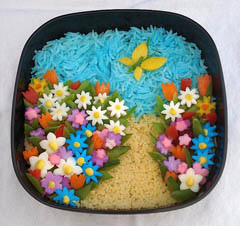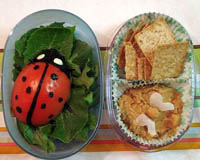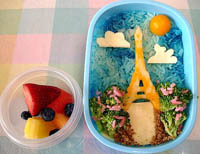A little bit about oekakiben
First of all…thanks, everyone, for the warm welcome! I’ll do my very best to keep you entertained until Biggie returns.
 As Biggie mentioned, I do oekaki (picture) bento. It’s not nearly as well-known as kyaraben, those amazing and intricate renderings of anime characters in lunchmeats, fishcake, egg products and nori. Whereas kyaraben take a great deal of patience and a deft hand with teeny, curl-prone shreds of dried seaweed, oekakiben are the refuge of rule-breakers like myself
As Biggie mentioned, I do oekaki (picture) bento. It’s not nearly as well-known as kyaraben, those amazing and intricate renderings of anime characters in lunchmeats, fishcake, egg products and nori. Whereas kyaraben take a great deal of patience and a deft hand with teeny, curl-prone shreds of dried seaweed, oekakiben are the refuge of rule-breakers like myself ![]() Instead of reproducing a popular image, we just make up our own, with whatever’s at hand.
Instead of reproducing a popular image, we just make up our own, with whatever’s at hand.
Like kyaraben, the oekakiben I do can sometimes take a while to put together, and people often ask me how long an assembly usually takes. I try to spend less than an hour making each bento, because after that it’s no longer fun. Ideally, if I already have an idea in mind, I can get the entire meal together in well under an hour. Like Biggie, I have a few speed tricks up my sleeve: making rice-backgrounds ahead of time, for example, so that they’re well-cooled by the time I need them, or having hard-boiled eggs at hand so that I have quick and easy access to cooked egg-white.
A very common misconception is that I crank these out every single day. I don’t; these are “special occasion” bento, and the time and effort involved mean more if it’s a once-in-a-while treat. I might get “inspired” and do two or three in as many days, but I also turn out my share of more standard bentos and even (gasp) cellophane-wrapped PB&J if I’m in a real hurry. Having to come up with new, exciting oekakiben ideas every single day could burn someone out in no time.
 The shapes and food-colorings might seem intimidating, but all you really need for making picture bento is a functional imagination. I call it “bento eyes”. Take a few minutes the next time you’re in your store’s produce section and examine a few fruits and vegetables. Does the cleft on the bottom of that strawberry remind you of a bunny’s face? Does the curve of that Roma tomato look a little like a ladybug? That sort of thing was how I got started; I saw food that resembled some object or creature, and then it was just a matter of filling in the blanks. I think everyone can grow “bento eyes” with a little practice.
The shapes and food-colorings might seem intimidating, but all you really need for making picture bento is a functional imagination. I call it “bento eyes”. Take a few minutes the next time you’re in your store’s produce section and examine a few fruits and vegetables. Does the cleft on the bottom of that strawberry remind you of a bunny’s face? Does the curve of that Roma tomato look a little like a ladybug? That sort of thing was how I got started; I saw food that resembled some object or creature, and then it was just a matter of filling in the blanks. I think everyone can grow “bento eyes” with a little practice.
A lot of it you learn as you go along, or happens when something goes right despite your best efforts. I was trying to make blue rice for a background, and I no ticed the bubbling of the rice cooker water had made the food coloring spread unevenly. When I took off the lid, I had goofed up my blue rice… but I was looking at a perfect cloudy sky. My mistake was better than what I’d had planned, and then the hard part was remembering what I’d done wrong so I could reproduce it!
ticed the bubbling of the rice cooker water had made the food coloring spread unevenly. When I took off the lid, I had goofed up my blue rice… but I was looking at a perfect cloudy sky. My mistake was better than what I’d had planned, and then the hard part was remembering what I’d done wrong so I could reproduce it!
Many people are put-off by the idea of blue rice (I get a lot of people emailing me specifically to inform me that they would never eat blue rice), but to tell you the truth — blue rice tastes like… rice! Pink egg white tastes like egg white. I try to make use of natural colors whenever I can, but I do use food coloring sometimes. I try to keep things in perspective; food colorings are so ubiquitous nowadays. They’re in everything from ketchup to sodas to candy to cereals… you’d have to try very hard to avoid them if you eat any processed foods at all. It takes very little coloring to tint a batch of rice or give a faint lavender glow to an eggwhite-blossom, and it’s not something I consume every single day. To me, it’s no better or worse than any other product out there that contains food coloring, and I’m ok with using it if there’s no other way to come up with the shade that I need. I guess it’s just a matter of getting over the mental hurdle of eating something that’s not the color you’d expect. Actually, a lot of kids find that sort of thing really fun.
In the coming week, I’ll talk a little more about a few picture-bento tips and tricks, along with some other things I’ve learned along the way, like outsmarting a troublesome seafood allergy. Let me know if there’s anything specific you’d like to discuss!





